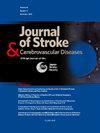Evaluating retinal blood vessels for predicting white matter hyperintensities in ischemic stroke: A deep learning approach
IF 2
4区 医学
Q3 NEUROSCIENCES
Journal of Stroke & Cerebrovascular Diseases
Pub Date : 2024-10-10
DOI:10.1016/j.jstrokecerebrovasdis.2024.108070
引用次数: 0
Abstract
Objective
This study aims to investigate whether a deep learning approach incorporating retinal blood vessels can effectively identify ischemic stroke patients with a high burden of White Matter Hyperintensities (WMH) using Nuclear Magnetic Resonance Imaging (MRI) as the gold standard.
Methods
In this cross-sectional study, we evaluated 263 ischemic stroke inpatients who had acquired both retinal fundus images and MRI images. The primary outcome was the diagnostic WMH on MRI brain, defined as different degrees of the age-related white matter changes (ARWMC) grade (<2 or ≥2). We developed a deep-learning network model with retinal fundus images to estimate WMH.
Results
The mean age of the patient cohort was 60.8 years, with 196 individuals (74.5%) being male. The prevalence of risk factors was as follows: hypertension in 237 (90.1%), diabetes in 109 (41.4%), hyperlipidemias in 84 (31.9%), coronary heart disease in 37 (14.1%), hyperhomocysteinemia in 70 (26.6%), and hyperuricemia in 73 (27.8%). Severe WMH defined as global ARWMC grade ≥2 was found in 139 (52.9%) participants. Using binocular fundus images, we achieved an F1 score of 0.811 and a Macro Accuracy of 0.811 in the ARWMC classification task. Additionally, we conducted experiments by progressively occluding fundus images to assess the relationship between different areas of the fundus images and ARWMC prediction.
Interpretation
Our study presents a novel deep learning model designed to detect a high burden of WMH using binocular fundus images in ischemic stroke patients. We have conducted initial investigations into the predictive significance of various fundus image areas for WMH identification. These findings underscore the need for broader data collection, further model training, and prospective data validation.
评估视网膜血管以预测缺血性中风的白质高密度:深度学习方法
研究目的本研究旨在探讨一种包含视网膜血管的深度学习方法能否以核磁共振成像(MRI)为金标准,有效识别白质高密度(WMH)的缺血性中风患者:在这项横断面研究中,我们对 263 名同时获得视网膜眼底图像和核磁共振成像的缺血性脑卒中住院患者进行了评估。主要结果是核磁共振成像脑部诊断性 WMH,定义为不同程度的年龄相关性白质改变(ARWMC)等级(结果:患者群的平均年龄为 65 岁:患者群的平均年龄为 60.8 岁,其中 196 人(74.5%)为男性。风险因素发生率如下:高血压 237 例(90.1%)、糖尿病 109 例(41.4%)、高脂血症 84 例(31.9%)、冠心病 37 例(14.1%)、高同型半胱氨酸血症 70 例(26.6%)和高尿酸血症 73 例(27.8%)。有 139 人(52.9%)发现了严重的 WMH,其定义为总体 ARWMC 等级≥2。使用双目眼底图像,我们在 ARWMC 分类任务中取得了 0.811 的 F1 分数和 0.811 的宏观准确率。此外,我们还通过逐步遮盖眼底图像进行了实验,以评估眼底图像不同区域与 ARWMC 预测之间的关系:我们的研究提出了一种新型深度学习模型,旨在利用双目眼底图像检测缺血性中风患者的高WMH负担。我们对眼底图像各区域对 WMH 识别的预测意义进行了初步研究。这些发现强调了更广泛的数据收集、进一步的模型训练和前瞻性数据验证的必要性。
本文章由计算机程序翻译,如有差异,请以英文原文为准。
求助全文
约1分钟内获得全文
求助全文
来源期刊

Journal of Stroke & Cerebrovascular Diseases
Medicine-Surgery
CiteScore
5.00
自引率
4.00%
发文量
583
审稿时长
62 days
期刊介绍:
The Journal of Stroke & Cerebrovascular Diseases publishes original papers on basic and clinical science related to the fields of stroke and cerebrovascular diseases. The Journal also features review articles, controversies, methods and technical notes, selected case reports and other original articles of special nature. Its editorial mission is to focus on prevention and repair of cerebrovascular disease. Clinical papers emphasize medical and surgical aspects of stroke, clinical trials and design, epidemiology, stroke care delivery systems and outcomes, imaging sciences and rehabilitation of stroke. The Journal will be of special interest to specialists involved in caring for patients with cerebrovascular disease, including neurologists, neurosurgeons and cardiologists.
 求助内容:
求助内容: 应助结果提醒方式:
应助结果提醒方式:


